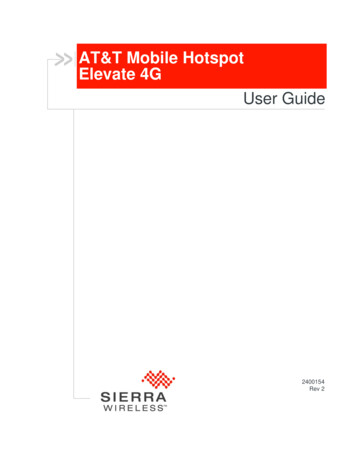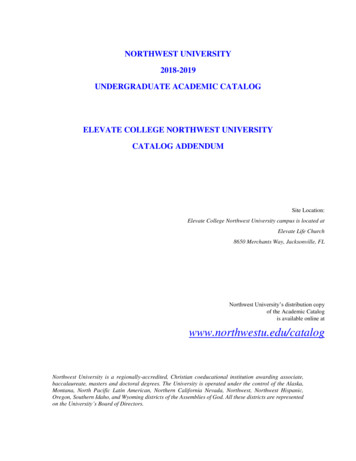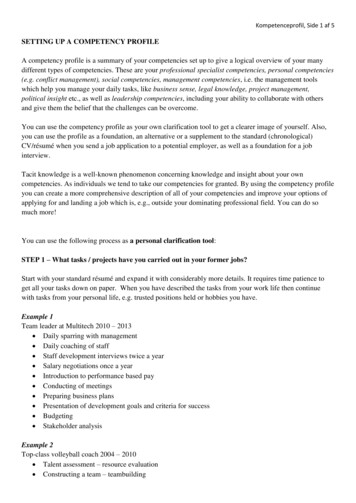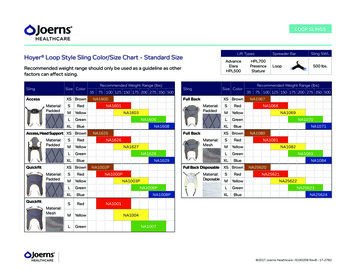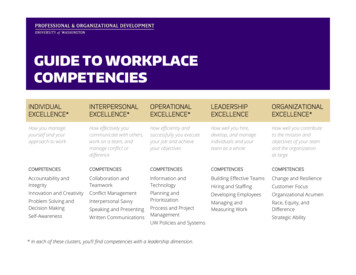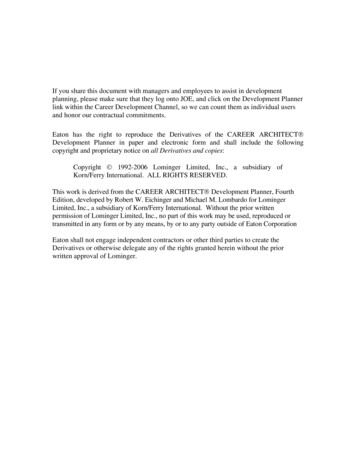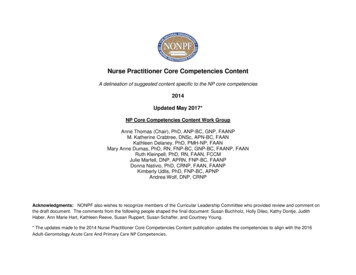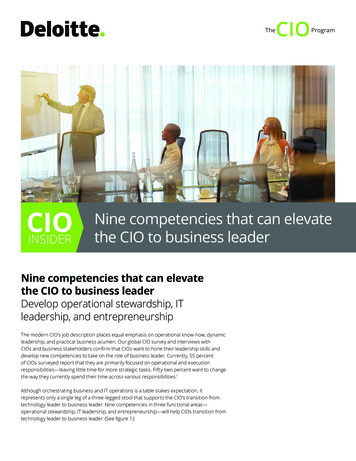
Transcription
CIOINSIDERNine competencies that can elevatethe CIO to business leaderNine competencies that can elevatethe CIO to business leaderDevelop operational stewardship, ITleadership, and entrepreneurshipThe modern CIO’s job description places equal emphasis on operational know-how, dynamicleadership, and practical business acumen. Our global CIO survey and interviews withCIOs and business stakeholders confirm that CIOs want to hone their leadership skills anddevelop new competencies to take on the role of business leader. Currently, 55 percentof CIOs surveyed report that they are primarily focused on operational and executionresponsibilities—leaving little time for more strategic tasks. Fifty-two percent want to changethe way they currently spend their time across various responsibilities.1Although orchestrating business and IT operations is a table stakes expectation, itrepresents only a single leg of a three-legged stool that supports the CIO’s transition fromtechnology leader to business leader. Nine competencies in three functional areas—operational stewardship, IT leadership, and entrepreneurship—will help CIOs transition fromtechnology leader to business leader. (See figure 1.)
CIOINSIDERNine competencies that can elevate the CIO to business leaderFigure 1. Competencies for Transitioning from Technology to Business LeaderFunctional ng businessoperations Driving agility Ensuring security and resilience Leveraging ecosystemsIT leadershipAnticipating and aligning Fusing business and technology strategywith business needs Developing talent Designing the IT operating modelEntrepreneurshipDelivering competitiveadvantageOperational stewardship: Optimizebusiness operationsSmooth and efficient IT operations areessential, but operational stewardship alsoincludes the ability to develop and delivercapabilities in anticipation of businessneeds, and to be agnostic about building,buying, or renting these capabilities.Competencies in this functional areainclude driving agility, ensuring securityand resilience, and leveraging partner andvendor ecosystems. Driving agility. CIOs must drive agilityin both the IT organization and theenterprise. Within the IT team, CIOscan build agile development, iterativeapplication development, and DevOpscapabilities that ensure higher deliveryspeed and lower defects. Within theenterprise, many CIOs grapple withexisting legacy and core environments—often decades old—that limit thebusiness. The decision to platform,revitalize, remediate, replace, or retrenchlegacy investments is complex, but it’snecessary to develop a more flexible,intuitive, and responsive back end thatsupports front-end agile processes andtechnologies such as sensors, connecteddevices, and analytics platforms.2 In ourglobal survey of CIOs, 40 percent of CIOs Shaping innovation Engaging customers Digitizing the enterprisetold us that they were planning to revitalizelegacy infrastructure and 27 percent saidthey planned to replace outdated systemswith new ones.3 Ensuring security and resilience. Sixtyone percent of CIOs surveyed identifiedmanaging risks and protecting digitalassets as a core expectation, and aboutthe same amount (64 percent) saidthey expect their technology spend oncybersecurity to increase over the nexttwo years.4 A critical operational goalis to proactively influence and educatebusiness leaders and employees oncybersecurity matters and developappropriate strategies for protectingnetworks and data. Leveraging ecosystems. The partner,vendor, and service provider ecosystemcan be an abundant source of ideasand innovation that can jumpstart ITcapabilities. To discover innovativesolutions for business problems, savvyCIOs extend their ecosystems to includeglobal incubators, innovation ecosystems,and innovation hubs. However, ourresearch revealed a gap in this area: only31 percent of CIOs view sourcing, vendormanagement, and leveraging suppliersand partners as essential to their success.5
CIOINSIDERNine competencies that can elevate the CIO to business leaderIT leadership: Anticipate and align withbusiness needsEqually important is the ability to lead theIT organization in lock-step with businesspriorities and goals. IT leadership includestaking charge of the department’s vision,operating model, talent and engagementstrategy, and culture. Competenciesincluding fusing business and technologystrategies, developing talent, and designingthe IT operating model. Fusing business and technologystrategies. Successful fusion of businessand IT priorities into a unified businesstechnology roadmap helps CIOs stayfocused on business outcomes. Anoverwhelming majority (78 percent)of CIO survey respondents agree thatstrategically aligning their departments withbusiness and performance goals andbusiness engagements is an organizationalcapability that is essential to their success.6Stakeholder influence is critical—global CIOsurvey results show that compared to otherCIOs, business-focused CIOs have thestrongest relationships with a widerspectrum of business leaders.7 Otherstrengths that contribute to thiscompetency are financial acumen anda keen understanding of markets anddisruptive forces. Developing talent. CIOs that participatedin our global CIO survey told us that talent isa key factor in determining CIOlegacy—the CIO’s long-term organizationalimpact.8 Forty-five percent say thatengaging, motivating, and acquiring talentis essential for success; however, only35 percent rank attracting and retainingtalent as a personal strength.9 Specializedtechnologists such as Java developersand ERP configurators will always beprized, but IT leaders are also seekingtalent with skills in experience design,data science, analytics, and other digitaltransformation-enabling skills. As an ITleader, the CIO supports high performers;provides opportunities to actively engagein multiple areas so that both IT andbusiness stakeholders can achieve career,business, and IT goals; and developsan IT culture where talent understandsbusiness drivers, customer expectations,and the external market. Designing the IT operating model.Strong technology governance processeshelp CIOs prioritize technologyinvestments, maintain accountability,and deliver business results. To achievemastery in IT leadership, CIOs ensurethe IT operating model—includingorganizational design, infrastructure,resources, processes, competencies,capabilities, and delivery models—meetscurrent and future business needs, isagile enough to facilitate both operationalexcellence and innovation, and supportsmultiple delivery speeds.10
CIOINSIDERNine competencies that can elevate the CIO to business leaderEntrepreneurship: Deliver competitiveadvantageLike an entrepreneur, CIOs that experimentwith new IT capabilities and emergingtechnologies—while leveraging stakeholderrelationships and knowledge about businesspriorities—can deliver a high level of valueto their organizations. Key competencies forentrepreneurship are shaping innovation,engaging customers, and digitizing theenterprise. Shaping innovation. To make technologydriven innovation an organizationalpriority, CIOs assign responsibility, allocatebudget, and demand accountability.Some are actively involved in scanning fordisruptive or innovative technologies andpursuing partnerships or acquisitions tobolster innovation capability. Yet it remainsa gap for the majority of CIOs—only 18percent describe their IT organization’scapability for innovation and disruptionas excellent or leading.11 CIOs that arehelping to shape innovation told us ininterviews that they delegate operationalresponsibilities, especially in areas thatdid not add competitive advantage. Manyuse service providers, but some havevery strong lieutenants that manageoperational responsibilities so CIOs canfocus on understanding and reacting tochanging market forces. Engaging customers. Forty-five percentof the CIOs we surveyed in 2015 saidthat customers were the No. 1 businesspriority; a year later, that percentageclimbed to 57 percent.12 IT and businessstrategies that are aligned enable—oreven drive—breakthrough innovationsthat result in new and more customercentric business models, markets, or evenindustries. For example, Boeing’s digitalaviation unit uses data from thousandsof aircraft-embedded, internet of things(IoT)-connected sensors to generateanalytics that enable predictive aircraftmaintenance, better fuel efficiency, andmore effective fleet management.13As customer experience becomes anincreasingly important competitionbattlefield, CIOs will leverage thiscompetency to digitally provide theirorganizations with an unprecedentedunderstanding of the behavior,preferences, and influence of individualcustomers. Digitizing the enterprise. By creating anenterprise-wise infrastructure that appliesdigital technologies to traditional productsand services, CIOs drive value across thebusiness. For example, technologies suchas robotic process automation, IoT, andpredictive analytics automate and dataenable manufacturing processes, drivenew supply chain models, and connectand automate consumer products forpredictive maintenance. The savvy CIOcombines a global, sophisticated view ofthe enterprise with holistic thinking aboutorganizational change and how it mayimpact the business.
CIOINSIDERNine competencies that can elevate the CIO to business leaderSelf-assessment: Transitioning tobusiness leaderMastering the nine competencies in thesethree functional areas can speed andsmooth the transition from technologyleader to business leader. There is nopre-determined formula that will work forevery CIO, and every CIO’s journey will beunique, depending on industry, market,customers, company, business priorities andchallenges, available talent and resources,CIO strengths and weaknesses, and otherfactors. The following self-assessmentcan help CIOs identify strengths andweaknesses in each area and develop a planfor filling any gaps.Rank your level of agreement with thefollowing statements based on the following5-point scale. Strongly Agree—5 points Agree—4 points Neutral—3 points Disagree—2 points Strongly Disagree—1 pointOperational Stewardship1. Our technology operations are efficientand effective, and our IT environment isreliable and compliant.2. We have strong IT governance to ensureprioritization, accountability, andtransparency.3. I deliver the majority of technologyprojects on budget and on time.4. I have built a robust ecosystem ofvendors, third parties, and partnerswhose capabilities we leverage.5. Our delivery teams use agilemethodologies to provide speed,flexibility, and iterative delivery.6. My business peers often engage me onoperational issues.7. We have a robust strategy to updatelegacy and core environments.8. We have strong protection, detection,and response capabilities forcybersecurity threats.IT Leadership1. I maintain deep relationships across thecompany and provide other leaders inmy organization with opportunities to dothe same.2. Every person in IT has a clearunderstanding of how they arecontributing to business value.3. We have a good talent acquisitionstrategy and are able to attract the besttalent in our market.4. We have a culture of high performancethat encourages healthy competition.5. I invest my time in engaging, mentoring,and providing stretch opportunities forIT staff.6. Our IT operating model (processes,people, capabilities, and technologies)fulfills current business needs and isevolving to address future needs.7. I expect high levels of performance, andmeasure and reward high performerswell.Entrepreneurship1. I enjoy making calculated bets to solvebusiness issues.2. I engage with end customers and aminvolved in delivering technology andbetter experiences for them.3. We have excellent sensing andprototyping capabilities for emergingtechnologies.4. I keenly follow our industry andmarketplace trends and visit customersregularly.5. Business leaders regularly seek myinput/feedback on business strategy.How to interpret the results Score between 80–100: Business Leader.If you scored 80 or more points, you havemany of the competencies embodiedby a CIO who is a business leader. Look atspecific areas where your score was lowand make any adjustments/coursecorrections as needed. Score between 60–80: FunctionalLeader. If your score is between 60 and 80,you are well on your way to becoming abusiness leader. Start by comparing yourscores in the three major categories todetermine which needs more attention;then examine individual responses in eachcategory to develop a plan for movingforward. Score 59 or less: Technology Manager.If you scored 59 or less, you likely need towork on all three of the functional areas.Determine your business need and goafter some quick wins, but to become abusiness leader, you shouldsimultaneously build capabilitiesin all three areas. Be aware of keydependencies—for example, you needgood talent to be an effective operationalsteward, and you may need to developinnovation competency to contribute tobusiness strategy.
CIOINSIDERNine competencies that can elevate the CIO to business leaderEndnotes1.Khalid Kark, Mark White, Bill Briggs, and Anjali Shaikh, Navigating legacy: Charting the course to business value, Deloitte University Press, p. 24, y.html, accessed January 18, 2017.2.Scott Buchholz, Ben Jones, Pavel Krumkachev, Reimagining core systems: Modernizing the heart of business, Deloitte University Press, , accessed January 18, 2017.3.Kark, White, Briggs, and Shaikh, Navigating legacy: Charting the course to business value, Deloitte University Press, p. 60.4.Kark, White, Briggs, and Shaikh, Navigating legacy: Charting the course to business value, Deloitte University Press, p. 18.5.Kark, White, Briggs, and Shaikh, Navigating legacy: Charting the course to business value, Deloitte University Press, p. 18.6.Kark, White, Briggs, and Shaikh, Navigating legacy: Charting the course to business value, Deloitte University Press, p. 56.7.Kark, White, Briggs, and Shaikh, Navigating legacy: Charting the course to business value, Deloitte University Press, p. 52.8.Kark, White, Briggs, and Shaikh, Navigating legacy: Charting the course to business value, Deloitte University Press, p. 56.9.Kark, White, Briggs, and Shaikh, Navigating legacy: Charting the course to business value, Deloitte University Press, p. 12.10. Mark White, Judy Pennington, Thomas Galizia, Mike Habeck, Right–speed IT: Living between black and white, Deloitte University l, accessed January 18, 2017.11. Kark, White, Briggs, and Shaikh, Navigating legacy: Charting the course to business value, Deloitte University Press, p. 47.12. Kark, White, Briggs, and Shaikh, Navigating legacy: Charting the course to business value, Deloitte University Press, p. 19.13. Clint Boulton, “Microsoft wins battle for Boeing in war with AWS,” CIO, August 2, -aws.html, accessed January 18, 2017.For additional information, please contact:Khalid KarkResearch DirectorUS CIO ProgramDeloitte LLPkkark@deloitte.comStay connected with itte.com@DeloitteOnTechAbout this researchDeloitte CIO Insider articles are developed with the guidance of Khalid Kark, Research Director, CIO Program, Deloitte Services LP.About Deloitte’s CIO ProgramCIOs lead unique and complex lives—operating at the intersection of business and IT to deliver value to their organizations. To help CIOs managethese challenges and issues, Deloitte has created the CIO Program. The program provides distinctive offerings to support the CIO career lifecyclethrough leadership development programs, immersive lab experiences, insight on provocative topics, and career transition support to complementthe technology services and solutions we provide to our clients.
This communication contains general information only, and none of Deloitte Touche Tohmatsu Limited, its member firms, or their relatedentities (collectively, the “Deloitte Network”) is, by means of this communication, rendering professional advice or services. Before makingany decision or taking any action that may affect your finances or your business, you should consult a qualified professional adviser. Noentity in the Deloitte Network shall be responsible for any loss whatsoever sustained by any person who relies on this communication.Copyright 2017 Deloitte Development LLC. All rights reserved.
business leader Mastering the nine competencies in these three functional areas can speed and smooth the transition f rom technology leader to business leader. There is no pre-determined formula that will work for every CIO, and every CIO's journey will be unique, depending on industry, market, customers, c ompany, business priorities a nd
